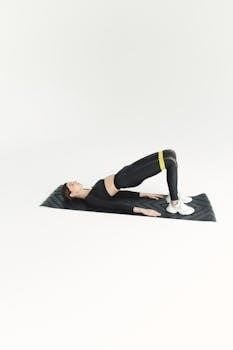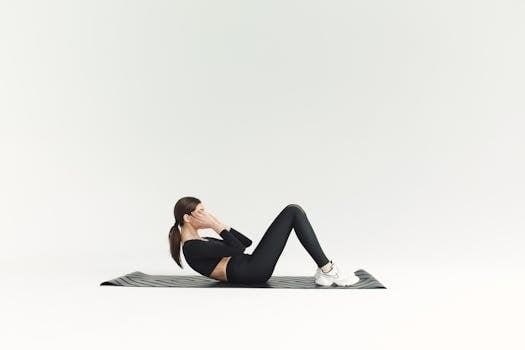
Embarking on a fitness journey often includes core strengthening․ It’s vital for stability and mobility, beginning at the body’s center․ This guide introduces beginner-friendly exercises to build a strong foundation and relieve back pain․
Importance of Core Strength
Core strength is more than just aesthetics; it’s the cornerstone of overall physical health․ Strong core muscles support the spine, aiding in maintaining good posture and preventing back pain․ A robust core enhances the functionality of leg and arm muscles, improving performance in everyday activities and sports․ Core stability is essential for preventing injuries and improving balance, making it crucial for beginners to focus on building this foundation․

Understanding Core Muscles
The core encompasses more than just abdominal muscles; it includes obliques, back, and pelvic muscles․ These muscles work together to stabilize the spine and maintain proper body alignment․
What Constitutes the Core
The core is not just the “six-pack” abs; it’s a complex network of muscles that stabilize your spine and pelvis․ It includes the rectus abdominis (the “abs”), obliques (sides), transverse abdominis (deep abs), erector spinae (back muscles), and even muscles around your hips and pelvis․ These muscles work together to provide support, allowing for movement and balance․ Strengthening these muscles is crucial for overall stability․
Why Core Stability Matters
Core stability is crucial for everyday movements and athletic performance; A strong core provides a solid base of support for the spine, helping to prevent back pain and injuries․ It improves posture, making you stand taller and more confident․ Furthermore, core stability enhances balance and coordination, which are essential for many physical activities․ In essence, a stable core makes all movements more efficient and reduces the risk of injury by supporting your body’s structure․
Beginner Core Exercises
This section introduces fundamental core exercises for beginners․ These movements focus on building strength and stability․ They are designed to be simple and effective․ Start slowly and focus on proper form․

Knee Planks
Begin by lying on your stomach, with elbows bent and weight on your forearms․ Lift your body, resting on your elbows and knees, keeping your back straight․ Engage your core by pulling your belly button toward your spine․ Avoid letting your hips drop or rise․ Remember to breathe during the exercise․ Hold this position for 30 seconds and gradually increase the duration as you become stronger․ This exercise establishes core stability․
Dead Bugs
Start by lying on your back, maintaining a neutral pelvic position․ Bend your knees at a 90-degree angle․ Slowly lower one leg at a time, keeping the opposite knee flexed at 90 degrees․ Focus on controlled movements and engaging your lower abdominal muscles․ Aim for one set per day, holding the pose for 2-4 minutes if good or 4-5 if great․ This exercise targets lower abs, hip flexors, and back muscles and promotes core stability․
Lateral Leg Rolls
Begin by lying face up with knees and hips bent, ankles slightly above the knees․ Preset your lower abdominals and then extend one leg․ Slowly roll your knees from side to side while keeping your shoulders flat on the floor․ Complete 2-4 sets of 4-6 repetitions, resting for 30 seconds between sets․ This exercise is great for improving core stability and engaging the oblique muscles, which are on the sides of your core․ You will also feel the abdominal muscles working․
Additional Beginner-Friendly Exercises
Beyond the basics, explore exercises like Bird Dog, which strengthens several core muscles, and Walk Outs, which can be modified to suit different fitness levels․ These will further enhance your core strength․
Bird Dog
The Bird Dog exercise is a fantastic move for beginners, targeting multiple core muscles simultaneously․ It involves starting on your hands and knees, then extending one arm forward and the opposite leg backward, maintaining a straight line from head to heel․ This exercise not only strengthens the core but also improves balance and stability, making it a valuable addition to any beginner’s routine․ Remember to keep your core engaged and avoid arching your back․
Walk Outs
Walk Outs are an effective exercise for beginners to engage the entire core․ Start standing, then bend down and place your hands on the floor․ Walk your hands forward until you’re in a plank position, then walk your hands back to your feet․ This movement strengthens the abdominals, shoulders, and back, promoting stability; For beginners, Walk Outs can be modified by starting from the knees․ Perform 3 sets of 10 reps․
Creating a Beginner Core Workout
Designing a beginner core workout involves understanding frequency and sets/reps․ Combining exercises effectively is crucial for a balanced routine․ This approach will help strengthen your core safely and effectively․
Frequency and Sets/Reps
For beginners, starting with core exercises two to three non-consecutive days a week is ideal, allowing for recovery․ Begin with one set of 15 repetitions for each exercise, gradually increasing to two or three sets as you get stronger․ Focus on maintaining proper form over quantity․ Rest adequately between sets and listen to your body’s signals to avoid overexertion․ Consistency and proper technique are key to building core strength effectively․
Combining Exercises
Creating an effective beginner core workout involves combining various exercises to target different muscle groups․ Include exercises that work the front, sides, and back of your core․ A balanced routine might incorporate planks for overall stability, dead bugs for deep core activation, and lateral leg rolls for obliques․ Start with a few exercises and gradually add more as you progress․ This comprehensive approach ensures you develop a well-rounded and strong core․ Remember to maintain proper form throughout each movement for the best results․
Benefits of Core Strengthening
Core strengthening offers numerous advantages, including back pain relief, improved posture, and enhanced sports performance․ A strong core is essential for overall body stability and function․
Back Pain Relief
A significant benefit of core strengthening is the alleviation of back pain․ Strong core muscles support the spine, reducing strain and discomfort․ Many back issues stem from weak core muscles, making targeted exercises crucial․ By developing core strength, individuals can stabilize their spine, improve posture, and reduce the likelihood of back pain․ Consistent core work provides a natural and effective way to manage and prevent back pain, promoting a healthier, more comfortable back and improved overall well-being․
Improved Posture
Core strengthening plays a crucial role in achieving and maintaining proper posture․ Strong core muscles support the spine, preventing slouching and promoting an upright stance․ Improved posture not only enhances physical appearance but also reduces strain on the back and neck․ By engaging in regular core exercises, individuals can develop the necessary stability to maintain good posture throughout the day․ This leads to better alignment, reduced muscle fatigue, and an overall improvement in body mechanics, which ultimately contributes to a healthier and more confident you․

Enhanced Sports Performance
A strong core is fundamental for enhanced sports performance across various disciplines․ It acts as a central power source, enabling efficient transfer of force between the upper and lower body․ Core strength improves balance, stability, and coordination, crucial for athletic movements like running, jumping, and throwing․ Athletes with a robust core can generate more power, move with greater agility, and reduce the risk of injuries․ Incorporating core exercises into a training regimen is essential for athletes looking to optimize their performance and achieve their full potential in their chosen sport․
Core Exercises at Home
Many effective core exercises can be done at home without equipment․ These exercises help to strengthen your core muscles, including abdominals, back and pelvis․ This makes it easy to start today․
No Equipment Needed
You can effectively strengthen your core using just your body weight, making it convenient to exercise at home․ Many foundational core exercises require no special gear, allowing for easy integration into your daily routine․ This approach emphasizes using your own resistance to build strength and stability, targeting key core muscles without the need for any equipment․ This method is perfect for beginners and those looking for a simple yet effective way to improve core strength and overall fitness․

Progression and Modifications
Adjusting exercises is crucial for all levels․ You can make them easier or harder to match your current ability․ This ensures continuous improvement and prevents injury, making workouts effective․
Adjusting for Different Levels
Core exercises should be modified to suit individual fitness levels․ Beginners can start with fewer repetitions or hold positions for shorter durations, focusing on proper form over intensity․ As strength increases, the difficulty can be progressed by adding reps, sets, or resistance․ Those with back pain can begin with gentle variations, ensuring a pain-free experience, while advanced individuals can explore more challenging options to continue their core strengthening journey, always prioritizing safety and proper engagement of core muscles․
Making Exercises Easier or Harder
To modify core exercises for different abilities, various techniques can be applied․ For easier variations, reduce the range of motion, decrease hold times, or perform exercises on hands and knees rather than feet․ Conversely, to increase difficulty, add weight, increase hold times, or perform exercises on unstable surfaces․ For example, knee planks can be modified to full planks, while dead bugs can add resistance with light weights․ Always ensure modifications support good form and avoid strain․
Printable PDF Resources
To assist your core strengthening journey, numerous printable PDF guides are available․ These resources offer visual aids and detailed instructions for various beginner-friendly core exercises, ensuring proper form and technique․
Finding Core Exercise Guides
Locating reliable core exercise guides is crucial for beginners․ Many reputable sources offer free, downloadable PDFs containing step-by-step instructions and visual aids․ Websites of health organizations, fitness professionals, and rehabilitation centers often provide these resources․ Look for guides specifically tailored for beginners, focusing on proper form and technique․ These PDFs can be a valuable tool to ensure you are performing exercises correctly and safely, maximizing benefits and minimizing injury risks․
Core Strength Beyond Aesthetics
Core strength extends past a toned appearance; it is essential for functional fitness․ A strong core prevents injuries, enhances balance, and supports daily movements, improving overall physical well-being․
Functional Strength
Functional strength, achieved through core training, translates to improved performance in daily tasks․ This goes beyond aesthetics, focusing on strengthening muscles used in everyday movements․ Enhanced core stability allows for better lifting, bending, and twisting motions, reducing the risk of injury and improving overall physical functionality․ A strong core provides the base for all movements, ensuring efficiency and stability in all activities․ It promotes balance and coordination, which are crucial for daily life․ Functional strength is the key to a healthier, more capable body․
Integrating Core Work into Routine
Core exercises can be incorporated as a standalone session or added to existing workouts․ This flexibility allows for easy integration into any fitness plan․ Consistency is key for optimal results․
As a Standalone or Part of Other Workouts
Core work offers versatility in your fitness routine․ It can serve as a dedicated workout, focusing solely on strengthening your midsection, or it can be seamlessly integrated into other training sessions, such as cardio or resistance training․ This adaptability allows you to customize your approach, fitting core exercises into your schedule and preferences․ Whether you choose a standalone core routine or incorporate it into other activities, consistency is key to achieving a stronger, more stable core․ This flexibility ensures you can prioritize core strength without disrupting your overall fitness goals․
Leave a Reply
You must be logged in to post a comment.